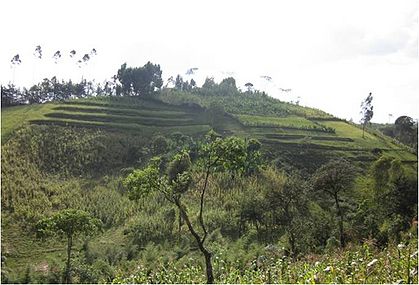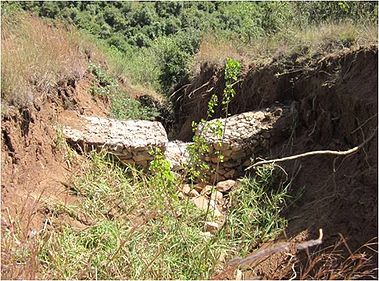Difference between revisions of "Mitigation and Intervention Techniques Related to Micro-hydro Power (MHP) Projects"
***** (***** | *****) m |
***** (***** | *****) m |
||
| Line 5: | Line 5: | ||
{| width="100%" cellspacing="1" cellpadding="1" border="0" class="FCK__ShowTableBorders" | {| width="100%" cellspacing="1" cellpadding="1" border="0" class="FCK__ShowTableBorders" | ||
|- | |- | ||
| − | | bgcolor="#990000" | ''' <span style="color: rgb(255, 255, 255);"> | + | | bgcolor="#990000" | ''' <span style="color: rgb(255, 255, 255);">BIOPHYSICAL MEASURES<ref>DESTA, L. ET AL. (2005): Part 2: Community Based Participatory Watershed Development: A Guideline. Addis Ababa: Ministry of Agriculture and Rural Development.</ref></span>''' |
| bgcolor="#990000" | <br> | | bgcolor="#990000" | <br> | ||
|- | |- | ||
| − | | bgcolor="#ffcc99" | Gully control | + | | bgcolor="#ffcc99" | '''Gully control''' |
| − | | bgcolor="#ffcc99" | | + | | bgcolor="#ffcc99" | '''Stone Checkdams''' |
| − | + | *<u>Objectives</u>: A stone checkdam is a structure across the bottom of a gully or a small stream, which reduces the velocity of runoff and prevents the deepening and widening of<br>the gully. Sediments accumulated behind a checkdam could be planted with crops or trees/shrubs grass and thus provide additional income to the farmer.<br> | |
| − | *Brushwood Checkdams | + | |
| − | *Gully Resheping, Filling and Revegetation | + | <br>'''Brushwood Checkdams'''<br> |
| − | *Sediment Storage and Overflow Earth Dams (SS Dams) for Productive Gulley Control<br> | + | |
| − | *Sediment Storage and Overflow Soil Bunds (SS Bunds) | + | *<u>Objectives</u>: Brushwood checkdams are vegetative measures constructed with vegetative materials, branches, poles/posts and twigs. Plant species which can easily grow vegetatively through shoot cuttings are ideal for this purpose. The objective of BWs is to retain sediments and slowdown runoff, and enhance the revegetation of gully areas. They are constructed either in single or double row. Some of the vegetation can be used for fodder. BWs are also ideal to stabilize conservation structures bunds, SS bunds, check dams, bench terraces, road sides, etc. |
| + | |||
| + | <br> | ||
| + | |||
| + | '''Gully Resheping, Filling and Revegetation''' | ||
| + | |||
| + | *<u>Objectives</u>: Reshaping & Filling is an operation meant to decrease the gully erosion angle of incidence, create planting areas and encourage revegetation & stabilization, usually in small gullies or in other medium sized gullies from which most runoff has been diverted into a stable waterway or drainage line.<br>When these gullies are shaped and smoothed, vegetation can be established over the levelled gullies.<br>Some of these areas can be used for farming purposes. Revegetation of a gully is the plantation of the reshaped gully sides and bottom with multipurpose species so that it reduces runoff and control erosion<br>and make the land productive. Gully revegetation implies reaching a dense vegetation cover over the entire gully surface, i.e. both sides and bottom by planting grasses, legumes and a variety of trees and shrubs.<br> | ||
| + | |||
| + | <br> | ||
| + | |||
| + | '''Sediment Storage and Overflow Earth Dams (SS Dams) for Productive Gulley Control'''<br> | ||
| + | |||
| + | *<u>Objectives</u>: SS dams are water harvesting and conservation systems that convert unproductive large and active gullies into productive areas (fertile cultivated or fodder producing areas, mixed plantations, and<br>fruit tree orchards). SS dams are stone-faced earth dams constructed across medium/large size gullies to trap sediments, collect water and divert excess runoff. SS dams accommodate the runoff generated by the catchment located above the gully. The structures are often constructed in series along the gully. It is just like creating a land that does not exist. Contribute significantly to protect cultivated lands,<br>arrest gully expansion and recharge water tables. Huge potential in Ethiopia - can provide tens of<br>thousand Km of gullies to poor households (small land holders and landless). | ||
| + | |||
| + | <br> '''Sediment Storage and Overflow Soil Bunds (SS Bunds)''' | ||
| + | |||
| + | *<u>Objectives</u>: SS bunds are large and strongly built soil embankments, constructed across gullies, often in series. As for SS dams, their purpose is to create a new field for cultivation by allowing and helping the sedimentation (filling) of the space behind each bund. After rains, the new fields fill up and retain enough soil and moisture to grow crops. The excess runoff move to the next structure downstream through a spillway. | ||
|- | |- | ||
| Line 144: | Line 160: | ||
<references />Per __NOTOC__ | <references />Per __NOTOC__ | ||
| + | |||
| + | <br> | ||
<br> | <br> | ||
[[Category:Ethiopia]] [[Category:Hydro]] | [[Category:Ethiopia]] [[Category:Hydro]] | ||
Revision as of 08:28, 23 April 2011
The identification of appropriate mitigation and intervention techniques on the basis of the Environment Assessment is crucial for the implementation of a successful Watershed Action Plan in order to achieve a sustainable use of the catchment area and thus the MHP project. Biophysical as well as political mitigation and intervention techniques are listed in the table below:
| BIOPHYSICAL MEASURES[1] | |
| Gully control | Stone Checkdams
Gully Resheping, Filling and Revegetation
Sediment Storage and Overflow Earth Dams (SS Dams) for Productive Gulley Control
|
| Agro-forestry, Forage Development and Forestry |
|
| Soil Fertility Management and Biological Soil Conservation |
|
| Flood Control and Improved Drainage |
|
| Physical Soil and Water Conservation |
|
| Water harvesting |
|
| POLITICAL MEASURES | |
| Education and training |
|
| Income generating measures |
|
| Participatory approach |

|

|
| Terracing in the Gobecho catchment (Ethiopia) | Gully control near Ambo (Ethiopia) |
Box 1 shows three examples of how (rather simple) interventions can improve the environmental condition of the catchment. A more detailed list of mitigation and intervention techniques and the respective application can be found in DESTA, L. ET AL. (2005): Part 1: Community Based Participatory Watershed Development. Addis Ababa: Ministry of Agriculture and Rural Development, pages 69 – 165 and DESTA, L. ET AL. (2005): Part 2: Community Based Participatory Watershed Development: Annex. Addis Ababa: Ministry of Agriculture and Rural Development, pages 43 - 48.
Box 1:
|
References
- ↑ DESTA, L. ET AL. (2005): Part 2: Community Based Participatory Watershed Development: A Guideline. Addis Ababa: Ministry of Agriculture and Rural Development.
- ↑ HELVETAS (2005): Helvetas Wasser Fact Sheet: Quellen und Quellschutz.
- ↑ GALE, J.A. (unknown): Watershedss Wetland Management. http://www.water.ncsu.edu/watershedss/info/wetlands/manage.html#prot
- ↑ SUNGSUMARN, K. (1993): Why Eucalyptus is Not Adopted for Agroforestry. In: Kashio, M. et al. (Hrsg.)(1996): Reports Submitted to the Regional Expert Consultation on Eucalyptus - Volume II. Bangkok: FAO Regional Office for Asia and the Pacific.
Per




















